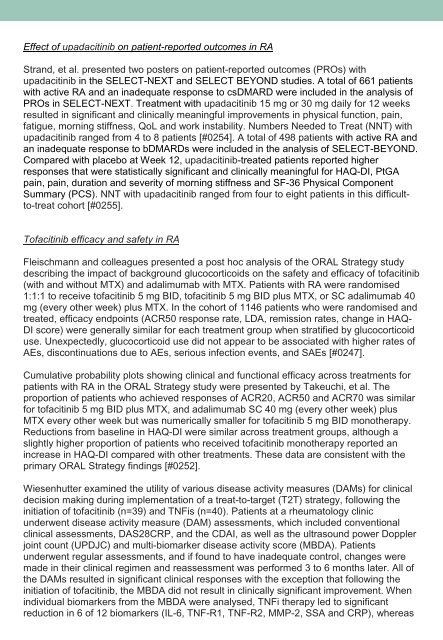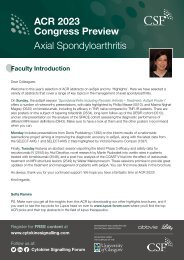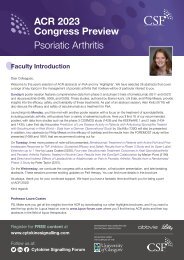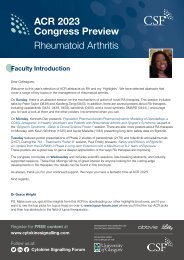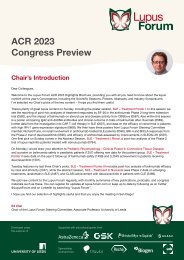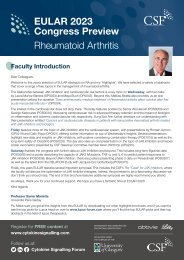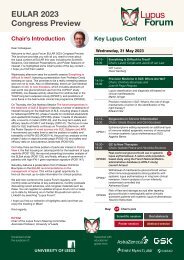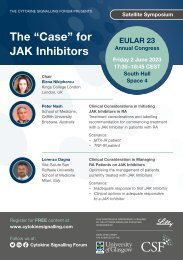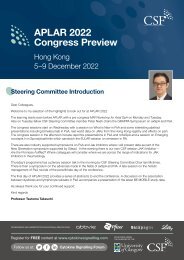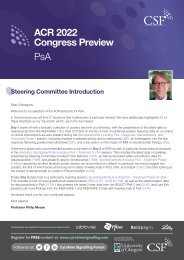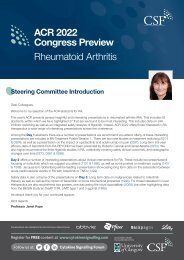EULAR 2018 Review
Create successful ePaper yourself
Turn your PDF publications into a flip-book with our unique Google optimized e-Paper software.
Effect of upadacitinib on patient-reported outcomes in RA<br />
Strand, et al. presented two posters on patient-reported outcomes (PROs) with<br />
upadacitinib in the SELECT-NEXT and SELECT BEYOND studies. A total of 661 patients<br />
with active RA and an inadequate response to csDMARD were included in the analysis of<br />
PROs in SELECT-NEXT. Treatment with upadacitinib 15 mg or 30 mg daily for 12 weeks<br />
resulted in significant and clinically meaningful improvements in physical function, pain,<br />
fatigue, morning stiffness, QoL and work instability. Numbers Needed to Treat (NNT) with<br />
upadacitinib ranged from 4 to 8 patients [#0254]. A total of 498 patients with active RA and<br />
an inadequate response to bDMARDs were included in the analysis of SELECT-BEYOND.<br />
Compared with placebo at Week 12, upadacitinib-treated patients reported higher<br />
responses that were statistically significant and clinically meaningful for HAQ-DI, PtGA<br />
pain, pain, duration and severity of morning stiffness and SF-36 Physical Component<br />
Summary (PCS). NNT with upadacitinib ranged from four to eight patients in this difficultto-treat<br />
cohort [#0255].<br />
Tofacitinib efficacy and safety in RA<br />
Fleischmann and colleagues presented a post hoc analysis of the ORAL Strategy study<br />
describing the impact of background glucocorticoids on the safety and efficacy of tofacitinib<br />
(with and without MTX) and adalimumab with MTX. Patients with RA were randomised<br />
1:1:1 to receive tofacitinib 5 mg BID, tofacitinib 5 mg BID plus MTX, or SC adalimumab 40<br />
mg (every other week) plus MTX. In the cohort of 1146 patients who were randomised and<br />
treated, efficacy endpoints (ACR50 response rate, LDA, remission rates, change in HAQ-<br />
DI score) were generally similar for each treatment group when stratified by glucocorticoid<br />
use. Unexpectedly, glucocorticoid use did not appear to be associated with higher rates of<br />
AEs, discontinuations due to AEs, serious infection events, and SAEs [#0247].<br />
Cumulative probability plots showing clinical and functional efficacy across treatments for<br />
patients with RA in the ORAL Strategy study were presented by Takeuchi, et al. The<br />
proportion of patients who achieved responses of ACR20, ACR50 and ACR70 was similar<br />
for tofacitinib 5 mg BID plus MTX, and adalimumab SC 40 mg (every other week) plus<br />
MTX every other week but was numerically smaller for tofacitinib 5 mg BID monotherapy.<br />
Reductions from baseline in HAQ-DI were similar across treatment groups, although a<br />
slightly higher proportion of patients who received tofacitinib monotherapy reported an<br />
increase in HAQ-DI compared with other treatments. These data are consistent with the<br />
primary ORAL Strategy findings [#0252].<br />
Wiesenhutter examined the utility of various disease activity measures (DAMs) for clinical<br />
decision making during implementation of a treat-to-target (T2T) strategy, following the<br />
initiation of tofacitinib (n=39) and TNFis (n=40). Patients at a rheumatology clinic<br />
underwent disease activity measure (DAM) assessments, which included conventional<br />
clinical assessments, DAS28CRP, and the CDAI, as well as the ultrasound power Doppler<br />
joint count (UPDJC) and multi-biomarker disease activity score (MBDA). Patients<br />
underwent regular assessments, and if found to have inadequate control, changes were<br />
made in their clinical regimen and reassessment was performed 3 to 6 months later. All of<br />
the DAMs resulted in significant clinical responses with the exception that following the<br />
initiation of tofacitinib, the MBDA did not result in clinically significant improvement. When<br />
individual biomarkers from the MBDA were analysed, TNFi therapy led to significant<br />
reduction in 6 of 12 biomarkers (IL-6, TNF-R1, TNF-R2, MMP-2, SSA and CRP), whereas


